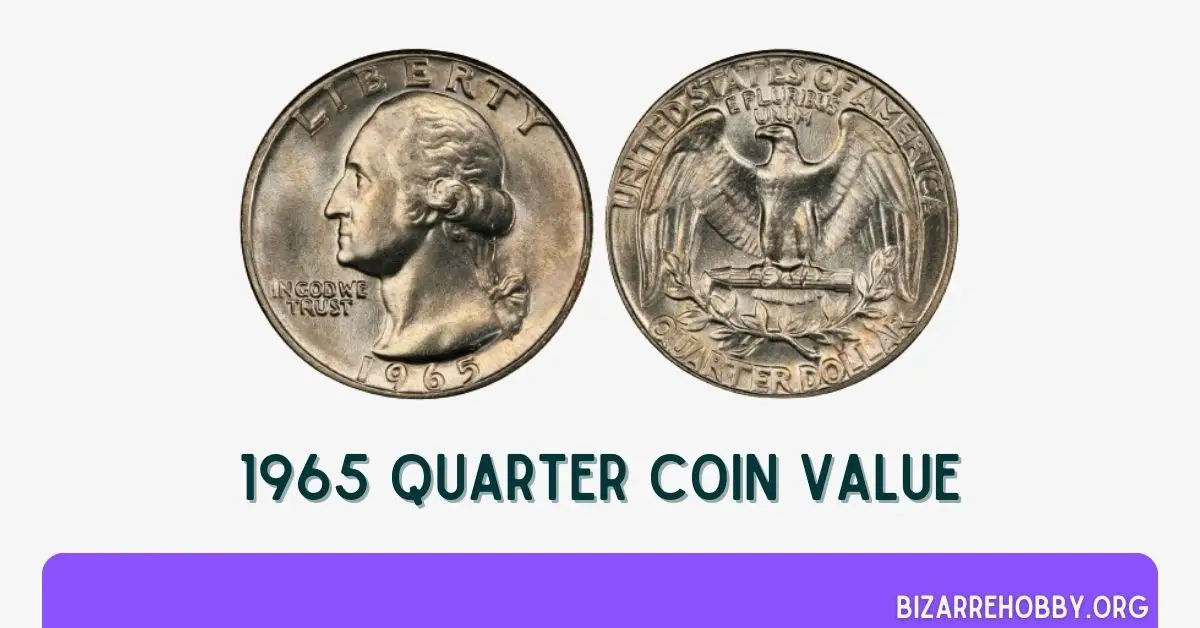Unearthed a 1965 quarter in your loose change and curious about its value? Look no further!
In this guide, we’ll delve into everything you need to know about the worth of a 1965 quarter. We’ll decode the specific qualities that excite collectors and equip you with the knowledge to distinguish between a common coin and a potentially valuable one.
Ready to uncover the hidden worth of your quarter? Let’s dive in!
1965 Quarter Value Chart
| Mint Mark | XF45 | MS63 | MS65 | MS67 |
|---|---|---|---|---|
| 1965 No Mint Mark Quarter Value | $0.25 | $8 | $22 | $400 |
| 1965 Special No Mint Mark Quarter Value | $1 | $10 | $16 | $32 |
| Cameo: $30 | Cameo: $85 | Cameo: $375 | ||
| Deep Cameo: $110 | Deep Cameo: $525 | Deep Cameo: $5,000 |
History Of The 1965 Quarter
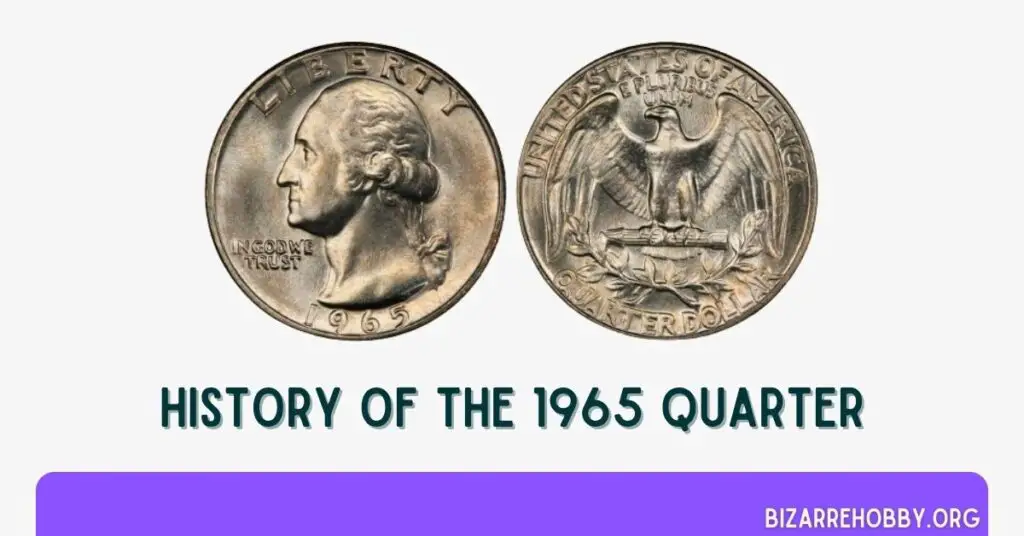
The year 1965 marked a turning point for the Washington quarter, a series honoring the first U.S. president launched in 1932, his 200th birthday. Originally minted with precious silver, these coins became caught in a fascinating economic tug-of-war.
By 1965, silver scarcity and rising production costs threatened the program. The increasing value of silver as a metal made the coins themselves more valuable than their face value. People began hoarding them, removing them from circulation.
The Mint initially tried to counter this by issuing dated-1964 quarters well into 1965, but it wasn’t enough. In June 1965, President Johnson made a significant announcement: silver dimes and quarters would be discontinued. A new era of clad coins, with a copper core layered in a copper-nickel alloy, would begin.
This switch wasn’t purely economic. The harder clad metal required a lower relief design to capture details effectively.
Interestingly, all 1965 Washington quarters came from the Philadelphia Mint and lacked mint marks. It wouldn’t be until 1968 that quarters from San Francisco (“S”) and Denver (“D”) would join the circulation party.
Philadelphia also catered to collectors, creating special “Mint Sets” containing these 1965 quarters with a unique satin finish alongside other denominations.
The Washington quarter continues to be minted today, a testament to its enduring place in American coinage. However, the story of the 1965 silver switch serves as a reminder of how economic forces can reshape even cherished traditions.
Features Of The 1965 Quarter
Here are some common features of the 1965 quarter.
The Obverse Of The 1965 Quarter
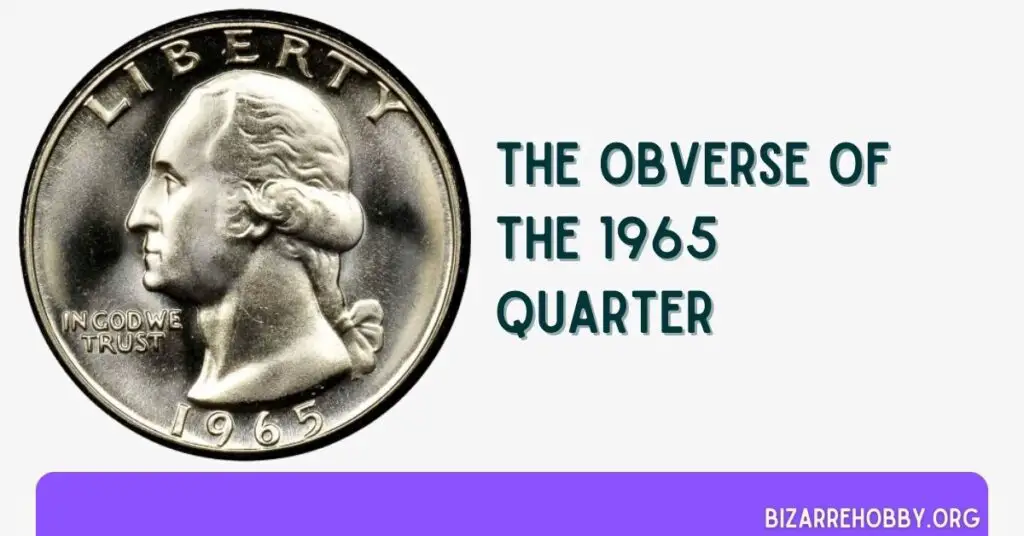
The face (obverse) of every Washington quarter proudly displays the image of its namesake, George Washington, the first President of the United States. This iconic portrait, sculpted by American artist John Flanagan, wasn’t always destined for the quarter.
Originally, a commemorative half dollar was planned to honor Washington’s bicentennial in 1932. A committee chose a design by Laura Gardin Fraser, showcasing Washington in profile. However, plans shifted. Instead of a limited-edition half dollar, Washington would be permanently celebrated on a continuously minted quarter.
This shift in purpose meant a new decision-maker: Treasury Secretary Andrew W. Mellon. Despite the committee’s recommendation for Fraser’s design, Mellon favored Flanagan’s portrait.
He left office before the final decision, and the committee appealed to his successor, Ogden L. Mills. Unfortunately, Mills declined to revisit Mellon’s choice, solidifying Flanagan’s design for the Washington quarter.
Both Fraser’s and Flanagan’s portraits drew inspiration from an earlier bust by French sculptor Jean-Antoine Houdon. Flanagan’s design presents a left-facing profile of Washington, framed by the curved inscription “Liberty” at the top. The date rests at the bottom, and “In God We Trust” sits to the left of Washington’s portrait.
While later quarters from Denver and San Francisco would display mint marks to the right of the portrait, all 1965 Washington quarters lack these additional markings.
The Reverse Of The 1965 Quarter

John Flanagan’s artistic touch extended beyond the obverse of the Washington quarter. He also designed the coin’s reverse, featuring a powerful image brimming with symbolism.
A bald eagle, the national bird of the USA, stands proudly at the center. Its outstretched wings symbolize strength and freedom, while the perch of bundled arrows represents the nation’s preparedness.
Below, two olive branches form a symbol of peace, signifying the country’s desire for both power and harmony.
The eagle’s dominance on the reverse wasn’t accidental. Its large, striking image takes up most of the coin’s surface, further emphasizing its significance as a national emblem.
Flanagan’s design cleverly integrates inscriptions that reinforce the patriotic message. The inscription “UNITED STATES OF AMERICA” crowns the eagle, a clear declaration of national identity. Below it, the Latin motto “E PLURIBUS UNUM” (“Out of Many, One”) references the unification of the individual states into a single nation.
Finally, the coin’s denomination, “QUARTER DOLLAR,” gracefully curves along the bottom edge of the reverse, completing the design.
Other Features Of The 1965 Quarter
At 24.3 millimeters in diameter and weighing 5.67 grams, the 1965 quarter fits comfortably in your palm. Take a closer look at its edge – you’ll notice a series of parallel grooves running vertically, known as a “reeded edge.”
This design choice has a fascinating history, dating back to the 18th century when coins were primarily made of precious metals like gold and silver. The reeded edge served a critical purpose: it helped prevent a nefarious practice called “coin clipping.”
In this scheme, unscrupulous individuals would shave off tiny bits of precious metal from the edges of coins, accumulating a small fortune over time. The reeded edge made such tampering readily apparent, as the grooves would be disrupted or removed entirely.
While coin clipping is less of a concern today, the reeded edge remains a distinctive feature. If you’re curious to see the 1965 quarter in more detail, a YouTube video by BigDCoins offers a close-up comparison with 1964 and 1966 dollars, providing a glimpse into the evolution of American coinage.
1965 Quarter Grading
| Grade Number | Grade |
|---|---|
| 1 | Basal State-1 |
| 2 | Fair |
| 3 | Very Fair |
| 4, 5, 6 | Good |
| 7, 8, 10 | Very Good |
| 12, 15 | Fine |
| 20, 30 | Very Fine |
| 40 | Extremely Fine |
| 50 | About Uncirculated |
| 60 | Mint State |
| 65 | Mint State |
| 70 | Mint State |
Please check our Washington quarter grading guide to know your coin scale, It’s the necessary step to know the exact value of your 1965 quarter.
1965 Quarter Value Guides
1965 No Mint Mark Quarter Value
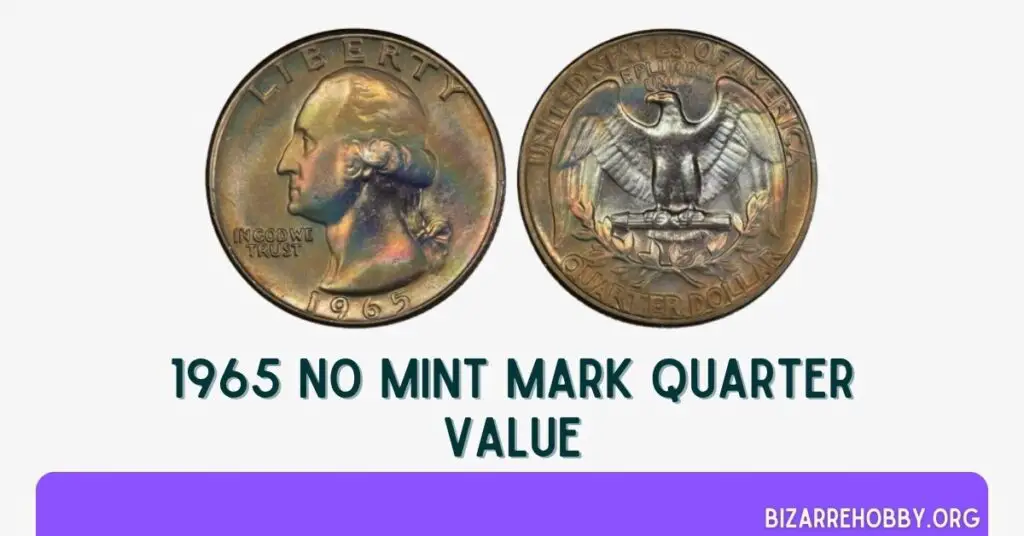
The Philadelphia Mint went into overdrive in 1965, producing a staggering 1.8 billion Washington quarters. Fortunately for collectors, the Professional Coin Grading Service (PCGS) estimates that around 455 million remain in existence today, making them readily available for enthusiasts.
However, this abundance translates to modest values for most circulated examples. These quarters will typically fetch only their face value of 25 cents. Exceptions, of course, exist – we’ll explore those fascinating error coins later.
Coin grading, a system ranging from 1 (poor) to 70 (flawless), plays a crucial role in determining a 1965 quarter’s worth. For a standard one to surpass its face value, it needs an MS62 (Mint State 62) grade or higher. The “MS” signifies the coin has never circulated.
Even within the mint state category, values can vary. Some MS60 coins, for instance, might only hold their face value. On the bright side, this affordability allows collectors to acquire attractive uncirculated examples without breaking the bank.
The value climbs noticeably at MS63, where a 1965 quarter can reach $8 according to PCGS. This increases further to $22 at MS65, which marks the entry point for “gem quality” coins.
A significant jump in value occurs between MS66+ (around $55) and MS67 ($400). This jump reflects the dramatic decrease in availability at MS67. Only a handful surpass this grade, with PCGS certifying just 13 finer examples.
Among these exceptional coins, 12 are graded MS67+, each valued at a remarkable $850. However, the pinnacle is a single MS68 specimen, considered the finest known example, boasting an impressive price tag of $16,500!
1965 Special No Mint Mark Quarter Value
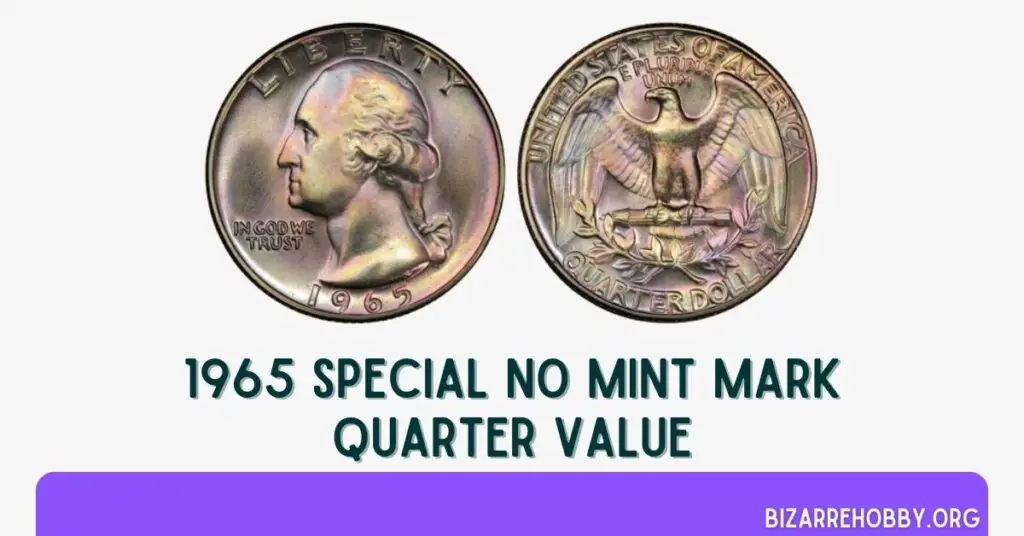
1965 marked a turning point for the Washington quarter. Not only was it the first year for the nickel-clad copper composition, but it also saw the introduction of “Special Mint Sets” aimed at collectors.
These sets, priced at $4 each, included a Lincoln cent, Jefferson nickel, Roosevelt dime, Washington quarter, and Kennedy half dollar. Interestingly, 2.3 million special strike Washington quarters were produced specifically for these sets, distinguished by their attractive satin finish.
Knowing their target audience, the Mint ensured these quarters were carefully minted, resulting in many being well-preserved today. While readily available, this abundance keeps prices modest for most grades.
The PCGS values “special strike” (designated by “SP”) 1965 quarters from SP40 to SP45+ at just $1 each. Even an SP63 merits only around $10, and a mint state SP65 reaches $16.
However, the story goes beyond standard grading. The true gems lie in the realm of “cameos” and “deep cameos.” These terms describe a desirable contrast between the coin’s glossy flat surfaces and its frosted raised areas, with “deep cameos” exhibiting the most dramatic effect.
The values mentioned so far apply to non-cameo coins. For cameos and deep cameos, the price tags skyrocket. A standard SP67 special strike might fetch $32, but a cameo at the same grade jumps to a staggering $375. And for a true “deep cameo,” the price explodes once again, reaching a potential $5,000!
Rare 1965 Quarter Error List
1965 (P) Quarter Double Die Obverse

The intricate designs adorning coins are transferred through a process called striking, using specialized dies. However, when errors occur during die creation, these imperfections get mirrored on the minted coins.
This is precisely the case with a fascinating subset of 1965 Washington quarters – the “double die obverse” (DDO) variety. These errors arise from misalignment or movement during the die striking process, resulting in a doubled image on the coin’s “heads” (obverse) side.
Multiple strikes are required to fully capture the design details on the die. If the die itself or the striking hub shifts between these strikes, a doubled image appears on the finished coins.
The 1965 DDO category boasts a couple of distinct varieties.
The rarest and most valuable one is coded FS-101 by the PCGS (Professional Coin Grading Service). Here, the doubling is readily apparent on most letters in “In God We Trust” and “Liberty,” along with the date and the left side of George Washington’s portrait.
The value spectrum for this variety is impressive, ranging from $40 for a poorly-preserved (grade 12) example to a staggering $1,000 for the finest known specimens, graded MS64 (Mint State 64).
A second variety, coded FS-102, exhibits a less prominent doubling, primarily affecting the word “Liberty.” Despite this difference, it still holds significant value. Even a grade 12 coin can fetch around $15, and the top-tier examples, graded MS65, can reach $750.
1965 (P) Quarter, Double Die Reverse
While double die obverse (DDO) errors can affect the heads side of a coin, similar mishaps can occur on the reverse die. This results in a “double die reverse” (DDR) error.
A specific subset of 1965 Washington quarters falls into this category, classified as variant FS-801 by the PCGS. These coins exhibit a doubling effect on the reverse design elements.
The good news for collectors? A 1965 Washington quarter with a double die reverse error carries significant value regardless of its condition. Even a poorly-preserved (grade 12) example can fetch around $40.
The pinnacle of value, however, rests with the highest-graded specimens. The finest examples discovered so far are graded MS64 (Mint State 64), with the PCGS placing a value of $1,400 on each of these exceptional coins.
Where To Sell Your 1965 Quarter?
Ready to turn your newfound coin knowledge into cash? Wondering where to find the best online marketplaces for selling your treasures? Look no further! We’ve curated a list of reputable online platforms, highlighting their benefits and potential drawbacks to guide you in your selling journey.
FAQs on 1965 Quarter Value
What Makes A 1965 Quarter Rare?
1965 quarters are common, but those with errors (like doubled lettering) or in top condition can be valuable. Look for doubling on the “heads” side, especially in lettering and Washington’s portrait.
How Much Is A 1965 Quarter Worth?
1965 quarters are typically worth 25 cents. However, rare errors or exceptionally high grades can bring much more. The most valuable known sold for $20,000.
